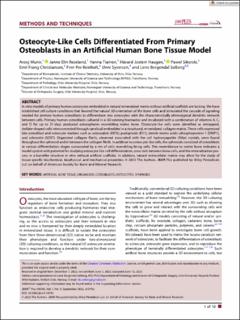| dc.description.abstract | In vitro models of primary human osteocytes embedded in natural mineralized matrix without artificial scaffolds are lacking. We have established cell culture conditions that favored the natural 3D orientation of the bone cells and stimulated the cascade of signaling needed for primary human osteoblasts to differentiate into osteocytes with the characteristically phenotypical dendritic network between cells. Primary human osteoblasts cultured in a 3D rotating bioreactor and incubated with a combination of vitamins A, C, and D for up to 21 days produced osteospheres resembling native bone. Osteocyte-like cells were identified as entrapped, stellate-shaped cells interconnected through canaliculi embedded in a structured, mineralized, collagen matrix. These cells expressed late osteoblast and osteocyte markers such as osteocalcin (OCN), podoplanin (E11), dentin matrix acidic phosphoprotein 1 (DMP1), and sclerostin (SOST). Organized collagen fibrils, observed associated with the cell hydroxyapatite (HAp) crystals, were found throughout the spheroid and in between the collagen fibrils. In addition to osteocyte-like cells, the spheroids consisted of osteoblasts at various differentiation stages surrounded by a rim of cells resembling lining cells. This resemblance to native bone indicates a model system with potential for studying osteocyte-like cell differentiation, cross-talk between bone cells, and the mineralization process in a bonelike structure in vitro without artificial scaffolds. In addition, natural extracellular matrix may allow for the study of tissue-specific biochemical, biophysical, and mechanical properties. | en_US |

